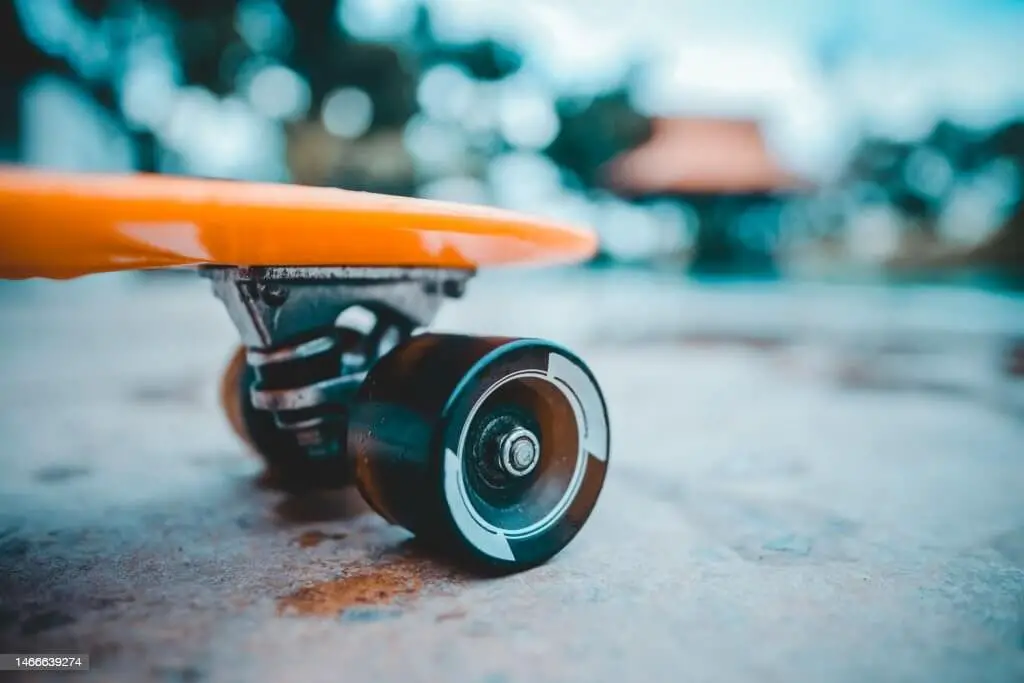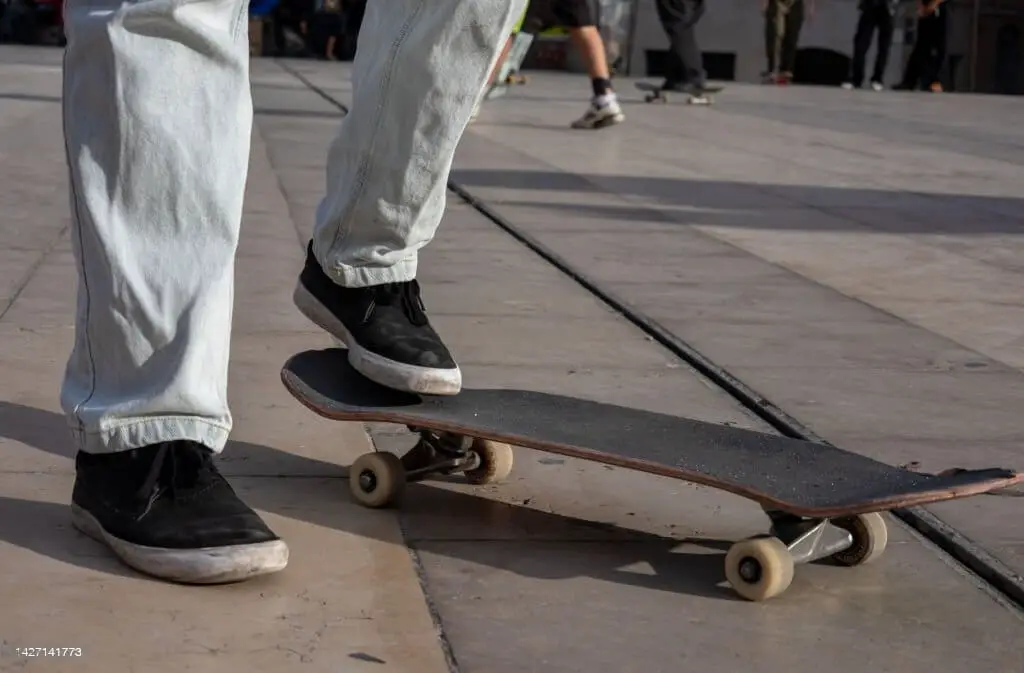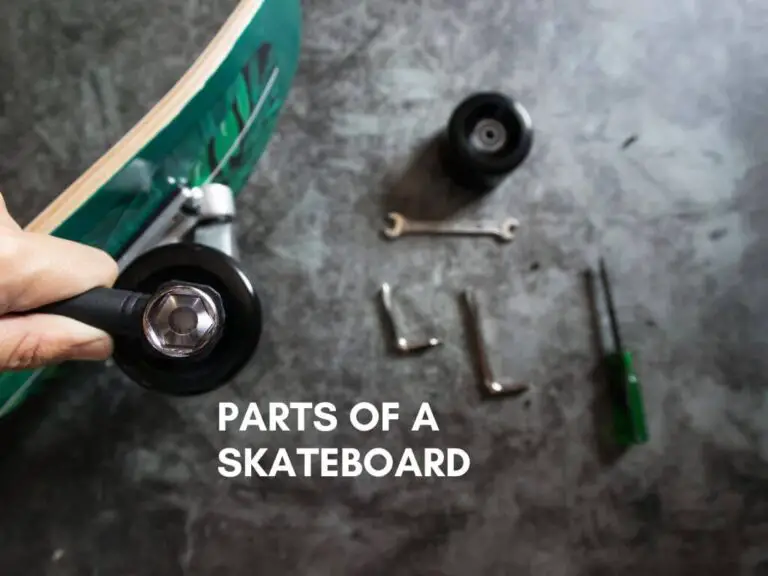Long Do Skateboard Wheels Last? Depends on use! Regular skaters replace every 3-6 months, but wheels can last 8-16 months with care. Size matters – bigger wheels last longer. Watch for wear, flat spots, and diameter drop below 50mm. Rotate wheels for extra life!
Skateboard wheels are an essential component of any skateboard, providing grip, control, and a smooth ride. However, skateboard wheels are not indestructible and will eventually wear out, requiring replacement. In this blog post, we’ll explore the various factors that affect skateboard wheel lifespan and provide you with a general estimate of how long you can expect your skateboard wheels to last.
Factors Affecting Skateboard Wheel Longevity
skateboarder doing a powerslide on his skateboard
Skateboard wheels are an essential component of any skateboard, and they play a vital role in your overall riding experience. However, skateboard wheels are not indestructible, and they will eventually wear out and need to be replaced. There are several factors that can affect the longevity of your skateboard wheels, including:

Wheel hardness:
Wheel hardness is measured on the Durometer A scale, with numbers ranging from 78A to 101A. Softer wheels, such as 78A or 80A wheels, are more comfortable to ride on rough surfaces, but they will wear out more quickly. Harder wheels, such as 99A or 101A wheels, are more durable and will last longer, but they can be harsher to ride on rough surfaces.
Skating style:
The way you ride your skateboard can also affect the longevity of your wheels. Aggressive skating techniques, such as powerslides and grinds, can put a lot of stress on your wheels and cause them to wear out more quickly. If you are an aggressive skater, you will want to choose harder wheels that can withstand the abuse.
Riding terrain:
The type of terrain you ride on can also affect the longevity of your skateboard wheels. If you ride on smooth pavement, your wheels will last longer than if you ride on rough asphalt or concrete. Rough surfaces can cause your wheels to wear down more quickly, and they can also increase the risk of flat spots and other damage.
Wheel maintenance:
Regular cleaning, lubrication, and rotation can help to extend the life of your skateboard wheels. Cleaning your wheels will help to remove dirt and debris that can cause premature wear. Lubricating your wheels will help to reduce friction and make them roll smoother. Rotating your wheels will help to ensure that they wear evenly.
Average Lifespan of Skateboard Wheels
Skateboard wheels are an essential component of your skateboard setup. They provide the grip and traction you need to skate safely and effectively. However, skateboard wheels are also consumable items. They will eventually wear out and need to be replaced.

How Long Do Skateboard Wheels Last?
The average lifespan of skateboard wheels can vary depending on a number of factors, including:
- The type of skating you do
- The terrain you skate on
- The quality of your wheels
- How often you skate
In general, skateboard wheels can last anywhere from a few weeks to several months. Casual riders who only skate a few times a week can expect their wheels to last much longer than street skaters or park skaters. Street skaters who do tricks and grind on obstacles will wear their wheels out much faster than casual riders. Park skaters who skate on ramps and transitions will also wear their wheels out faster than casual riders.
Casual Riders
Casual riders who only skate a few times a week can expect their wheels to last anywhere from 3 to 6 months. However, if you skate on rough terrain, your wheels will wear out faster.
Street Skaters
Street skaters who do tricks and grind on obstacles can expect their wheels to last anywhere from 1 to 3 months. However, if you skate on rough terrain or do a lot of grinds, your wheels will wear out faster.
Park Skaters
Park skaters who skate on ramps and transitions can expect their wheels to last anywhere from 1 to 2 months. However, if you skate on rough terrain or do a lot of airs, your wheels will wear out faster.
Signs Your Skateboard Wheels Need Replacement
Skateboarding is an exhilarating and enjoyable activity that requires a well-maintained skateboard to ensure a safe and enjoyable ride. Just like any other vehicle, skateboards require regular maintenance, and one of the most crucial components to keep in top shape are the wheels.
Over time, skateboard wheels endure wear and tear due to friction and impacts, leading to a deterioration in their performance and safety. Recognizing the telltale signs of worn-out skateboard wheels is essential for skateboarders to prevent injuries and maintain a smooth and controlled ride.
1. Flat Spots
Flat spots are one of the most common and noticeable signs of worn-out skateboard wheels. They occur when a specific portion of the wheel’s surface becomes worn down more quickly than the rest, resulting in an uneven and bumpy ride. Flat spots disrupt the smooth roll of the wheels, causing the skateboard to vibrate and making it difficult to maintain balance and control.
2. Uneven Wear
Uneven wear is another common sign of skateboard wheels that need replacement. This occurs when the wheels wear down at different rates, often due to factors such as improper alignment, asymmetric weight distribution, or a combination of both. Uneven wear can lead to unstable rides, making it challenging to maintain balance and control, especially at higher speeds.
3. Reduced Diameter
Significant wear can cause the diameter of the skateboard wheels to shrink. This reduction in size can affect the skateboard’s performance and stability in several ways. Smaller wheels tend to lose momentum more quickly, making it harder to maintain speed and requiring more effort to push and accelerate. Additionally, the reduced diameter can lower the skateboard’s center of gravity, potentially making it more prone to tipping over.
4. Cracks and Chunks
Cracks and chunks in the skateboard wheels are serious signs of wear and tear and should be addressed immediately. Cracks can weaken the wheel’s structure, increasing the risk of breakage and potential injuries. Chunks, on the other hand, can cause the wheels to catch on surfaces or become unbalanced, posing a safety hazard.
5. Sluggish Performance
Over time, skateboard wheels can become sluggish and unresponsive, making it harder to maneuver and control the skateboard. This loss of performance can be attributed to factors such as worn-out bearings, dirt and debris buildup, or a combination of both. Regularly cleaning and maintaining the wheels and bearings can help extend their lifespan and prevent sluggish performance.
6. Difficulty Turning
If you notice that your skateboard is becoming increasingly difficult to turn, it could be a sign that your wheels are worn out. As wheels wear down, they lose their ability to grip the surface, making it harder to initiate and execute turns. This can be particularly dangerous in situations where quick maneuvers are required to avoid obstacles or changes in direction.
7. Excessive Noise
Skateboard wheels should roll smoothly and quietly. If you notice that your wheels are making excessive noise, such as grinding, squealing, or clunking, it could be a sign that they need to be replaced. Worn-out wheels can rub against the bearings or the skateboard deck, causing unpleasant noises and potentially damaging the components.
8. Vibration and Wobbliness
Vibration and wobbliness during rides can indicate worn-out skateboard wheels. As wheels become uneven or lose their shape, they can cause the skateboard to vibrate excessively, making it difficult to maintain balance and control.
9. Reduced Shock Absorption
Skateboard wheels play a crucial role in absorbing shock and vibrations from the ground. As wheels wear down, they lose their ability to cushion impacts, making the ride harsher and less comfortable. This can lead to fatigue and discomfort, especially during long rides or on rough surfaces.
10. Impaired Grip
Skateboard wheels provide grip on the surface, allowing riders to control their movements and maintain balance. Worn-out wheels can lose their grip, making it difficult to maneuver and control the skateboard, especially on slippery surfaces or during wet conditions. This can increase the risk of slipping and falling.
Prolonging the Life of Your Skateboard Wheels

To help you extend the life of your skateboard wheels and keep them rolling smoothly for longer, we’ve compiled a comprehensive guide with practical tips and insights.
1. Rotate Wheels Regularly for Even Wear
Just like car tires, skateboard wheels tend to wear unevenly over time. This uneven wear can lead to premature replacement and compromise the overall performance of your skateboard.
Regularly rotating your wheels ensures that all four wheels wear at the same rate, effectively doubling their lifespan. To rotate your wheels, simply follow these steps:
- Remove each wheel from the axle.
- Switch the front wheels with the rear wheels and vice versa.
- Securely tighten the axle nuts on all four wheels.
Aim to rotate your wheels every few rides or after a noticeable difference in wear between the front and rear wheels.
2. Embrace Smooth Riding Techniques
While aggressive skating techniques like grinds and slides can add a touch of flair to your skateboarding, they also put significant strain on your wheels, accelerating their wear and tear.
For beginners and those seeking to prolong the life of their wheels, it’s advisable to focus on smoother riding styles. This includes techniques like carving, pumping, and cruising, which put less stress on the wheels while still allowing you to enjoy the thrill of skateboarding.
3. Choose the Right Wheel Hardness for Your Riding Style and Terrain
Wheel hardness, measured on the durometer scale (A), plays a significant role in wheel durability and performance. Softer wheels (50A-60A) offer a smoother ride and better grip, but they tend to wear out faster. Harder wheels (65A-75A) provide more durability and speed, but they may not be as comfortable on rough surfaces.
Selecting the appropriate wheel hardness depends on your riding style and terrain preferences. If you prefer smooth rides on paved surfaces, softer wheels are a good choice. If you enjoy riding on rougher terrain or engaging in aggressive skating, harder wheels offer better durability.
4. Perform Regular Maintenance for Optimal Wheel Health
Just like any other part of your skateboard, wheels require regular maintenance to keep them in top condition and extend their lifespan. Here’s a simple maintenance routine to follow:
- Cleaning: Use a soft cloth or brush to wipe down your wheels regularly to remove dirt, debris, and small pebbles that can accelerate wear.
- Lubrication: Apply a small amount of skateboard wheel lubricant to the bearings to reduce friction and prevent premature wear.
- Inspection: Regularly inspect your wheels for cracks, chips, or other signs of damage. If you notice any damage, it’s time to replace the affected wheels.
Conclusion
How Long Do Skateboard Wheels Last? Skateboard wheels can last anywhere from a few months to several years, depending on various factors such as the type of wheels, riding style, and terrain. Softer wheels wear down faster than harder ones, and aggressive skating or riding on rough surfaces can significantly shorten the lifespan of wheels. Regularly rotating your wheels can help extend their life. If you notice significant wear, flat spots, or reduced performance, it’s time to replace your skateboard wheels.
FAQ’s
Why do my skateboard wheels stop so fast?
Skateboard wheels stop rapidly primarily due to friction. The contact between the wheels and the ground generates friction, converting the kinetic energy into heat and slowing down the skateboard. Rough surfaces, small obstacles, and poor-quality bearings amplify this effect. Smoother wheels with higher quality bearings can reduce friction and enhance roll time. Regular maintenance, cleaning debris from bearings, and keeping the skateboard in good condition also contribute to a longer and smoother ride.
When should I replace my skateboard wheels?
Replace skateboard wheels when they show significant wear and tear. Signs include flattened edges, unevenly worn surfaces, decreased grip, and reduced speed. Regularly inspect for cracks or chunks missing from the wheels. If you notice increased difficulty in riding or less smoothness, it’s likely time for new wheels. Upgrading wheels can enhance performance and safety, ensuring a better skating experience.
Do you need to replace skateboard wheels?
Yes, replacing heels is necessary when they become worn. Over time, wheels wear down due to friction, rough surfaces, and tricks. Signs include decreased grip, slower speed, and uneven wear. New wheels improve performance, ensuring a smoother and safer ride. Consider replacement if you notice these issues or seek specific features like different hardness levels for various terrains or styles of riding.
Do longboard wheels expire?
Longboard wheels don’t have an expiration date, but they do wear out over time due to usage and friction. Their performance can diminish as they become smaller, smoother, and lose grip. Inspect for visible cracks, uneven wear, and reduced responsiveness. Upgrading wheels can refresh your ride, especially if seeking better speed, traction, or slide control. While they don’t “expire” like food, it’s recommended to replace worn-out longboard wheels to maintain safety and optimal performance.
How do I know if my skateboard wheels are bad?
Look for flat spots (uneven wear), cracks, or major size reduction. Feel for wobbly bearings or excessive vibration. If riding feels rough, slows down quickly, or makes loud noises, it’s probably time for new wheels!








